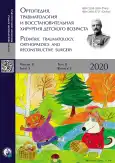Результаты хирургического лечения сгибательной контрактуры лучезапястного сустава у детей с церебральным параличом методом временного внесуставного артродеза
- Авторы: Новиков В.А.1, Умнов В.В.1, Умнов Д.В.1
-
Учреждения:
- Федеральное государственное бюджетное учреждение «Национальный медицинский исследовательский центр детской травматологии и ортопедии имени Г.И. Турнера» Министерства здравоохранения Российской Федерации
- Выпуск: Том 8, № 3 (2020)
- Страницы: 281-292
- Раздел: Оригинальные исследования
- URL: https://bakhtiniada.ru/turner/article/view/34151
- DOI: https://doi.org/10.17816/PTORS34151
- ID: 34151
Цитировать
Аннотация
Обоснование. Хирургические подходы к лечению сгибательной контрактуры лучезапястного сустава делят на мягкотканные вмешательства (удлинения или пересадки сухожилий) и костные операции, стабилизирующие лучезапястный сустав. Мы разработали методику временного артродеза лучезапястного сустава, в которой учтены преимущества обоих подходов: стабильность артродеза при установленной металлоконструкции и возможность активных движений в лучезапястном суставе после удаления конструкции.
Цель — сравнительная оценка эффективности нового метода хирургического лечения сгибательной контрактуры лучезапястного сустава у детей с церебральным параличом, включающего временный внесуставной артродез и пересадку сгибателей кисти на разгибатели по Green.
Материалы и методы. Исследование предполагало сравнительный анализ лечения двух групп пациентов. Пациентам первой группы (n = 13) выполняли пересадку сухожилия m. flexor carpi ulnaris на m. extensor carpi radialis brevis/longus (операция Green). Пациентам второй группы (n = 13) проводили временное артродезирование лучезапястного сустава накостной пластиной сроком на год. Результаты лечения в первой и второй группах анализировали через год после выполнения артродеза и удаления пластинки и через год после пересадки мышц. Пациенты второй группы после удаления металлоконструкций проходили 14-дневный курс реабилитации до оценки результата лечения. Оценивали амплитуду активных и пассивных движений в лучезапястном суставе, а также функциональные возможности верхней конечности с помощью международной системы классификации MACS (2002) и Block and Box test.
Результаты. У пациентов первой группы пассивная амплитуда движений увеличивалась (+9,7°). У пациентов обеих групп существенно увеличивалась амплитуда активных движений (31,9° — в первой и 45,7° — во второй). Показатель функциональности верхней конечности MACS для оценки состояния руки в целом оказался практически идентичен в обеих группах. У пациентов первой группы средняя динамика Block and Box test в результате лечения составила 8 дополнительных кубиков, а у пациентов второй группы — всего 1,6.
Заключение. Операция Green менее эффективна в сравнении с операцией временного артродеза в качестве метода коррекции сгибательной контрактуры лучезапястного сустава, но функциональные показатели после операции Green выше. Выбор методики оперативного лечения основан на следующих моментах: в случае высокой функциональной перспективы выполняют операцию Green, в случае коррекции тяжелой контрактуры с сомнительными функциональными перспективами — временный артродез.
Полный текст
Открыть статью на сайте журналаОб авторах
Владимир Александрович Новиков
Федеральное государственное бюджетное учреждение «Национальный медицинский исследовательский центр детской травматологии и ортопедии имени Г.И. Турнера» Министерства здравоохранения Российской Федерации
Автор, ответственный за переписку.
Email: novikov.turner@gmail.com
ORCID iD: 0000-0002-3754-4090
канд. мед. наук, научный сотрудник отделения детского церебрального паралича
Россия, Санкт-ПетербургВалерий Владимирович Умнов
Федеральное государственное бюджетное учреждение «Национальный медицинский исследовательский центр детской травматологии и ортопедии имени Г.И. Турнера» Министерства здравоохранения Российской Федерации
Email: umnovvv@gmail.com
ORCID iD: 0000-0002-5721-8575
д-р мед. наук, ведущий научный сотрудник отделения детского церебрального паралича
Россия, Санкт-ПетербургДмитрий Валерьевич Умнов
Федеральное государственное бюджетное учреждение «Национальный медицинский исследовательский центр детской травматологии и ортопедии имени Г.И. Турнера» Министерства здравоохранения Российской Федерации
Email: dmitry.umnov@gmail.com
ORCID iD: 0000-0003-4293-1607
канд. мед. наук, научный сотрудник отделения детского церебрального паралича
Россия, Санкт-ПетербургСписок литературы
- Miller F. Cerebral palsy. New York: Springer-Verlag; 2005.
- Van Heest AE, Bagley A, Molitor F, James MA. Tendon transfer surgery in upper-extremity cerebral palsy is more effective than botulinum toxin injections or regular, ongoing therapy. J Bone Joint Surg Am. 2015;97(7):529-536. https://doi.org/10.2106/JBJS.M.01577.
- Клочкова О.А., Куренков А.Л., Намазова-Баранова Л.С., и др. Общее моторное развитие и формирование функции рук у пациентов со спастическими формами детского церебрального паралича на фоне ботулинотерапии и комплексной реабилитации // Вестник РАМН. – 2013. – Т. 68. – № 11. – С. 38–48. [Klochkova OA, Kurenkov AL, Namazova-Baranova LS, et al. Development of motor functions and manual abilities in pediatric patients with spastic cerebral palsy after botulinum toxin treatment and complex rehabilitation. Vestn Ross Akad Med Nauk. 2013;68(11):38-48. (In Russ.)]
- Lee JS, Lee KB, Lee YR, et al. Botulinum toxin treatment on upper limb function in school age children with bilateral spastic cerebral palsy: One year follow-up. Ann Rehabil Med. 2013;37(3):328-335. https://doi.org/10.5535/arm.2013.37.3.328.
- Carlson MG. Cerebral palsy. In Green’s operative hand surgery. 5th ed. Ed. by D.P. Green, M.D. Pederson, R.N. Hotchkiss, S.W. Wolf. Philadelphia: Elsevier Churchill Livingstone; 2005. P. 1197-1234.
- Salazard B, Medina J. The upper limb of children with cerebral palsy: Surgical aspects. Chir Main. 2008;27 Suppl 1:S215-221. https://doi.org/10.1016/ j.main.2008.07.024.
- Nachemson A. Tendon transfer in cerebral palsy. In: Fridén J. Tendon transfers in reconstructive hand surgery. Oxford: Taylor & Francis; 2005. P. 133-148.
- van Heest AE, Strothman D. Wristarthrodesis in cerebralpalsy. J Hand Surg Am. 2009;34(7):1216-1224. https://doi.org/10.1016/j.jhsa.2009.03.006.
- Thabet AM, Kowtharapu DN, Miller F, et al. Wrist fusion in patients with severe quadriplegic cerebral palsy. Musculoskelet Surg. 2012;96(3):199-204. https://doi.org/10.1007/s12306-012-0217-0.
- Wei DH, Feldon P. Total wrist arthrodesis: Indications and clinical outcomes. J Am Acad Orthop Surg. 2017;25(1):3-11. https://doi.org/10.5435/JAAOS-D-15-00424.
- Новиков В.А., Умнов В.В., Звозиль А.В. Тактика лечения сгибательной контрактуры лучезапястного сустава у детей с детским церебральным параличом // Ортопедия, травматология и восстановительная хирургия детского возраста. – 2014. – Т. 2. – № 3. – С. 40–47. [Novikov VA, Umnov VV, Zvozil AV. Тreatment strategy of flexion contracture of the wrist joint in children with cerebral palsy. Pediatric traumatology, orthopaedics and reconstructive surgery. 2014;2(3):40-47. (In Russ.)]. https://doi.org/10.17816/PTORS2340-46.
- Патент РФ № 2593743/ 14.07.2016. Умнов В.В., Новиков В.А. Способ устранения сгибательной контрактуры лучезапястного сустава у больных с детским церебральным параличом. [Patent RUS No. 2593743/ 14.07.2016. Umnov VV, Novikov VA. Sposob ustraneniya sgibatel’noy kontraktury luchezapyastnogo sustava u bol’nykh s detskim tserebral’nym paralichom. (In Russ.)]
- Rayan GM, Young BT. Arthrodesis of the spastic wrist. J Hand Surg Am. 1999;24(5):944-952. https://doi.org/10.1053/jhsu.1999.0944.
- Alexander RD, Davids JR, Peace LC, Gidewall MA. Wrist arthrodesis in children with cerebral palsy. J Pediatr Orthop. 2000;20(4):490-495.
- Neuhaus V, Kadzielski JJ, Mudgal CS. The role of arthrodesis of the wrist in spastic disorders. J Hand Surg Eur Vol. 2015;40(5):512-517. https://doi.org/10.1177/1753193414530193
Дополнительные файлы















